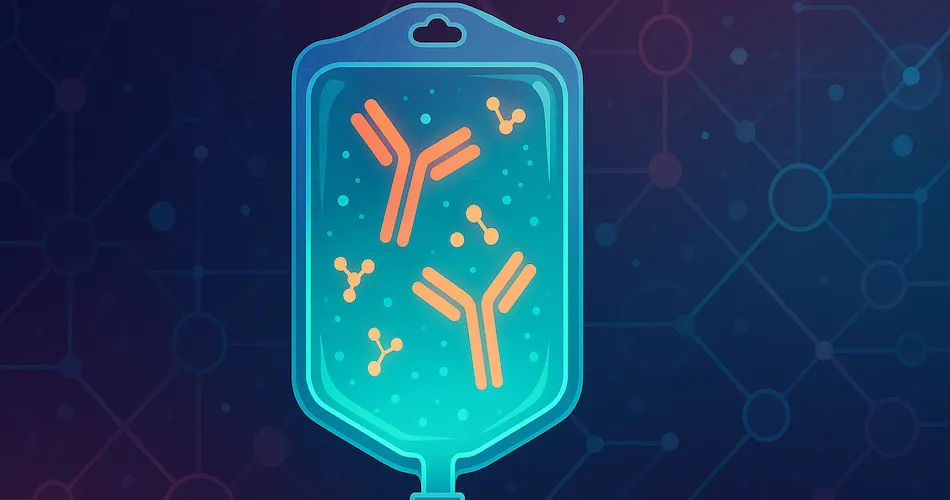ORIC-533 : A New Small Molecule to Treat Multiple Myeloma

Keeping up with the recent advances in the treatment of myeloma has rapidly become more than a full-time task over the past few years. We are constantly witnessing advancements in cell therapy, monoclonal antibodies, and bi- and tri-specifics. These target various clusters of differentiation (CD) that can be found on the surface of myeloma cells, T cells, or natural killer cells. Additionally, there are novel small molecules, and altogether, are providing patients with an ever-increasing number of current and future treatment options for different stages of the disease.
The most recent issue of the Blood Cancer Journal included a letter to the Editor that goes into some serious detail about the method of action of ORIC-533, a clinical-stage product from the San Francisco-based ORIC Pharmaceuticals.
How ORIC-533 Works: Targeting the Adenosine Pathway
This drug in development is a small molecule (compared to, e.g., monoclonal antibody drugs such as Darzalex or Sarclisa) and can be administered orally (something we, patients, happen to like). Let me try and provide a simplified version of how ORIC-533 works:
Many cancers can take over an anti-inflammatory pathway called the adenosine pathway to avoid detection by the immune system. This can reduce the effectiveness of certain chemotherapy and immunotherapy-based treatments. When adenosine gathers inside the bone marrow in myeloma, it can suppress the immune system and lead to tumor growth. Adenosine itself can suppress the immune system, decreasing the activity of many immune cell types, such as T cells, natural killer cells, and dendritic cells. Myeloma patients have higher adenosine levels.
CD73 controls the rate of adenosine production. Higher CD73 levels are associated with worse outcomes in several cancers, including multiple myeloma. ORIC-533 is an oral CD73 inhibitor that blocks adenosine production, restoring and enhancing immune function. Lab testing on multiple myeloma cells shows that blocking CD73 could restore anti-cancer immunity and trigger significant cell death of myeloma cells.
Early Findings from the ORIC-533 Phase 1b Study
The company has already published the early results of the ORIC-533 Phase Ib study. Phase I studies are geared towards establishing the initial safety and efficacy profile of a new compound and are also used to define the dosing regimen for future clinical studies and (hopefully) future commercial use. The results of this study can be summarized as follows:
- ORIC-533 was administered once daily in 4 different doses (400-1600 mg) to a group of 17 patients.
- All patients were refractory to at least three classes of drugs, with 88% of them being refractory to five classes of drugs.
- 59% of the patients had previously undergone treatment with either anti-BCMA/CD3 bispecific therapy or anti-BCMA CAR-T therapy.
- ORIC-533 was considered as generally well-tolerated: a total of 10 treatment-related side effects were reported in 5 patients.
- Fatigue was the only severe adverse event (Grade 3) and the only treatment-related side effect seen in more than 1 patient.
- All other events were either mild or moderate (Grade 1-2) and seen in only 1 patient each.
- After one treatment cycle, there was evidence of an increase in the number of circulating NK and CD8+ T cells (subtypes of white blood cells that target and kill cancer cells). There are some early signs that the highest doses helped activate CD8+ T-cells in both the blood and bone marrow.
Looking Ahead: The Future of ORIC-533 for Myeloma
Study information indicates that the Phase I study of ORIC-533, which is still recruiting participants, will be completed around mid-year 2024. I expect that once the full set of data for this cohort of patients is public, the company will start recruiting for the next phase study to support a future regulatory filing (if future results continue to come in positive).
This is a compound to keep an eye on. With some luck, we will see another addition to the armamentarium of treatment options in the next 4-5 years that may/will give some of us added hope as we continue our myeloma journey.
Don't miss out on the latest breakthroughs and updates on Multiple Myeloma! Join the HealthTree Foundation newsletter community today and stay informed.
SUBSCRIBE TO MYELOMA NEWSLETTER
Sources:
Keeping up with the recent advances in the treatment of myeloma has rapidly become more than a full-time task over the past few years. We are constantly witnessing advancements in cell therapy, monoclonal antibodies, and bi- and tri-specifics. These target various clusters of differentiation (CD) that can be found on the surface of myeloma cells, T cells, or natural killer cells. Additionally, there are novel small molecules, and altogether, are providing patients with an ever-increasing number of current and future treatment options for different stages of the disease.
The most recent issue of the Blood Cancer Journal included a letter to the Editor that goes into some serious detail about the method of action of ORIC-533, a clinical-stage product from the San Francisco-based ORIC Pharmaceuticals.
How ORIC-533 Works: Targeting the Adenosine Pathway
This drug in development is a small molecule (compared to, e.g., monoclonal antibody drugs such as Darzalex or Sarclisa) and can be administered orally (something we, patients, happen to like). Let me try and provide a simplified version of how ORIC-533 works:
Many cancers can take over an anti-inflammatory pathway called the adenosine pathway to avoid detection by the immune system. This can reduce the effectiveness of certain chemotherapy and immunotherapy-based treatments. When adenosine gathers inside the bone marrow in myeloma, it can suppress the immune system and lead to tumor growth. Adenosine itself can suppress the immune system, decreasing the activity of many immune cell types, such as T cells, natural killer cells, and dendritic cells. Myeloma patients have higher adenosine levels.
CD73 controls the rate of adenosine production. Higher CD73 levels are associated with worse outcomes in several cancers, including multiple myeloma. ORIC-533 is an oral CD73 inhibitor that blocks adenosine production, restoring and enhancing immune function. Lab testing on multiple myeloma cells shows that blocking CD73 could restore anti-cancer immunity and trigger significant cell death of myeloma cells.
Early Findings from the ORIC-533 Phase 1b Study
The company has already published the early results of the ORIC-533 Phase Ib study. Phase I studies are geared towards establishing the initial safety and efficacy profile of a new compound and are also used to define the dosing regimen for future clinical studies and (hopefully) future commercial use. The results of this study can be summarized as follows:
- ORIC-533 was administered once daily in 4 different doses (400-1600 mg) to a group of 17 patients.
- All patients were refractory to at least three classes of drugs, with 88% of them being refractory to five classes of drugs.
- 59% of the patients had previously undergone treatment with either anti-BCMA/CD3 bispecific therapy or anti-BCMA CAR-T therapy.
- ORIC-533 was considered as generally well-tolerated: a total of 10 treatment-related side effects were reported in 5 patients.
- Fatigue was the only severe adverse event (Grade 3) and the only treatment-related side effect seen in more than 1 patient.
- All other events were either mild or moderate (Grade 1-2) and seen in only 1 patient each.
- After one treatment cycle, there was evidence of an increase in the number of circulating NK and CD8+ T cells (subtypes of white blood cells that target and kill cancer cells). There are some early signs that the highest doses helped activate CD8+ T-cells in both the blood and bone marrow.
Looking Ahead: The Future of ORIC-533 for Myeloma
Study information indicates that the Phase I study of ORIC-533, which is still recruiting participants, will be completed around mid-year 2024. I expect that once the full set of data for this cohort of patients is public, the company will start recruiting for the next phase study to support a future regulatory filing (if future results continue to come in positive).
This is a compound to keep an eye on. With some luck, we will see another addition to the armamentarium of treatment options in the next 4-5 years that may/will give some of us added hope as we continue our myeloma journey.
Don't miss out on the latest breakthroughs and updates on Multiple Myeloma! Join the HealthTree Foundation newsletter community today and stay informed.
SUBSCRIBE TO MYELOMA NEWSLETTER
Sources:

about the author
Paul Kleutghen
I am a patient diagnosed in 2014 with primary plasma cell leukemia (pPCL), a rare and aggressive variant of multiple myeloma and have been very fortunate to find successful treatment at the division of Cellular Therapy at the Duke University Cancer Institute. My wife, Vicki, and I have two adult children and two grandsons who are the ‘lights of our lives’. Successful treatment has allowed Vicki and I to do what we love best : traveling the world, albeit it with some extra precautions to keep infections away. My career in the pharmaceutical industry has given me insights that I am currently putting to use as an advocate to lower drug pricing, especially prices for anti-cancer drugs. I am a firm believer that staying mentally active, physically fit, compliant to our treatment regimen and taking an active interest in our disease are keys to successful treatment outcomes.
More on Clinical Trials
Trending Articles
Upcoming Events




Get the Latest Multiple Myeloma Updates, Delivered to You.
By subscribing to the HealthTree newsletter, you'll receive the latest research, treatment updates, and expert insights to help you navigate your health.
Together we care.
Together we cure.
3x Faster.













